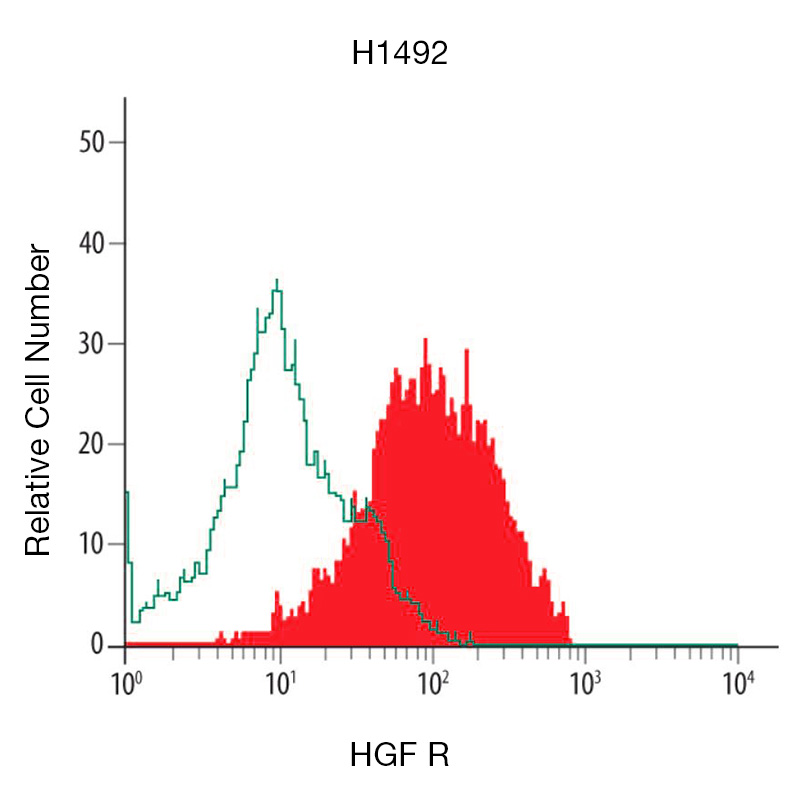Anti-Human HGF R – Biotin
Data
- -
- -
Antibody DetailsProduct DetailsReactive Species Human Host Species Goat Immunogen Purified Recombinant Human HGF R (Accession # P08581) Formulation This biotinylated antigen affinity purified polyclonal antibody has been 0.2 µm filtered and lyophilized from modified Dulbecco’s phosphate buffered saline (1X PBS) pH 7.2 – 7.3 containing 50 µg of bovine serum albumin per µg of antibody with no calcium, magnesium, or preservatives present. State of Matter Lyophilized Storage and Handling The lyophilized, biotinylated antigen affinity purified polyclonal antibody can be stored desiccated at -20°C to -70°C for up to twelve months from date of receipt. The reconstituted bioin conjugate can be stored for at least four weeks at 2-8°C. For long-term storage of the reconstituted conjugate, aseptically aliquot into working volumes and store at -20°C to -70°C in a manual defrost freezer. Avoid Repeated Freeze Thaw Cycles. No detectable loss of activity was observed after six months. Country of Origin USA Shipping Next Day Ambient RRIDAB_2830328 Applications and Recommended Usage? Quality Tested by Leinco Flow Cytometry: It is recommended to use the indirect method for signal enhancement when enumerating cells expressing HGF R. A suggested method would be to stain cells expressing HGF R with 0.50 µg per 1-2.5 x 106 cells in a total staining volume of ≤200 µl followed by PN:A104. Western Blotting: To detect Human HGF R this biotin conjugate can be used at a concentration of 0.1 - 0.2 µg/ml. This biotin conjugate should be used in conjunction with compatible second-step reagents such as PN:A106 and a chromogenic substrate such as PN:T343. The detection limit for Human HGF R is 25 ng/lane under either reducing or non-reducing conditions. The sensitivity of detection may increase up to 50 fold when a chemiluminescent substrate is used. A suitable Western blotting control is PN:H1476. ELISA Sandwich Assay: This antibody can be used as the detection antibody in a sandwich ELISA at a concentration of approximately 0.1-0.4 µg/ml. Each investigator should determine their own optimal working dilution for specific applications. See directions on lot specific datasheets, as information may periodically change. DescriptionDescriptionSpecificity Goat Anti-Human Hepatocyte Growth Factor Receptor (HGF R) recognizes Human HGF R. This antigen affinity purified polyclonal antibody was purified using a proprietary chromatographic technique that includes covalently immobilizing the antigen proteins or peptides to agarose based beads. This purification method enhances specificity, reduces nonspecific binding of extraneous IgG and provides you with the most reliable reagent available for your early discovery research. Background Hepatocyte growth factor receptor (HGFR), also known as c-Met, plays an important roles in angiogenesis and tumor growth.1 C-Met is a receptor tyrosine kinase expressed by epithelial cells of the brain, kidney, liver and other tissues. Binding of its ligand, Hepatocyte Growth Factor (HGF), triggers receptor autophosphorylation, and activation of several downstream effectors including the mitogen-activated protein kinases ERK-1 and ERK-2, and PLC-γ. Activation of the c-Met signal transduction pathway leads to mulitple cellular responses including cell motility, scattering, proliferation, survival and angiogenesis.2,3 PubMed NCBI Gene Bank ID UniProt.org Research Area Other Molecules References & Citations1. McDonald, DM. et al. (2008) BMB Rep. 41: 833 2. Park, M. et al. (1998) Oncogene 16: 833 3. Comoglio, PM. et al. (1998) J Cell Sci. 111: 237 Technical ProtocolsCertificate of Analysis |
Related Products
- -
- -
Prod No. | Description |
|---|---|
H1481 | |
H1487 | |
H1476 | |
H1477 | |
H1493 | |
H1492 |



